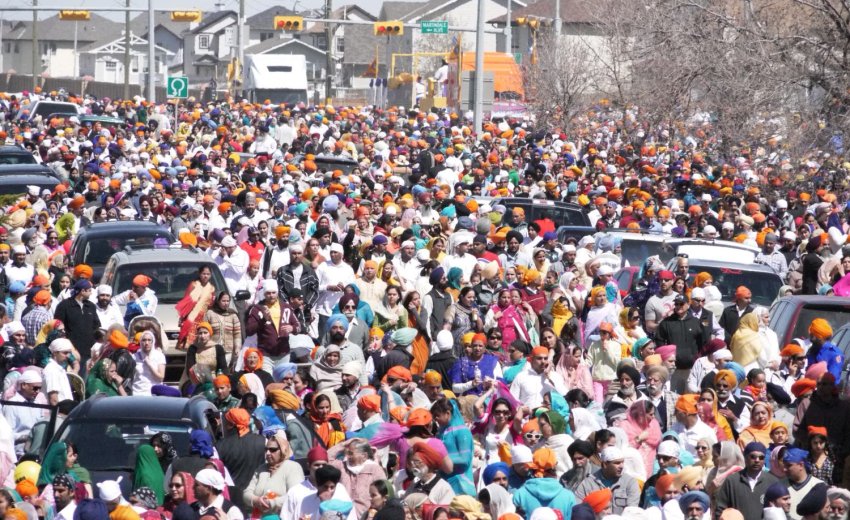Years ago, I attended a Sikh retreat far from home - outside of the United States and outside of my “normal crowd.” It was interesting to experience Sikh life in a different country...and I think Bono had it right when he said, “We are one, but we’re not the same.”
The first morning we all woke up at Amrit Vela and joined in Nit-Nem and Shabad Keertan. Everybody was in to it and nobody seemed distracted. It was one of those powerful “Sangat” experiences where you lose yourself and become part of the whole. I loved it! I was so energized after that Deevan and was excited for all the weekend’s activities to come...then came breakfast. It was a little chaotic as we entered the dining hall. Although the meals were vegetarian (God help us if they weren’t), a group of Singhs were arguing with the aunties demanding to see the packaging for the bread. They were convinced that this particular brand of bread had an animal byproduct as an ingredient.I skipped the bread and quickly moved pass, but finding a place to sit became an ordeal in itself. Although there were at least 50 people at the retreat, less than half were eating in the dining hall. I looked around and saw a handful of Singhs back in the kitchen sitting together eating from Sarab Loh bowls, cups, and plates. Another group of Singhs were heading back to their dorms to eat the food they brought, as their maryada only permitted them to eat food prepared by other Amritdharis who followed their same maryada. As for me, I felt like the new kid walking in the cafeteria on the first day of school trying to figure out which group I could fit in to. What happened to that warm and fuzzy feeling I had sitting in the Deevan? Now this Sangat, who couldn’t share a meal together, felt cold and distant.
Turns out mealtime wasn’t the only time we found ourselves at odds. We spent much of the weekend arguing over how many Baanis one should read daily, or whether Raag Mala is Baani, or the authenticity of Dasam Granth, or whether Keertan should only be sung in Raag. We even debated over what colors should be prohibited for Sikhs to wear. Considering I grew up in a Sikh community that still argues over whether keeping “Kesh” is necessary, this was all quite a culture shock. The whole experience was difficult for me to swallow.
I thought to myself…with all the challenges we as a community face in the real world, it is disheartening to see how disjointed and fragile we really are. If we can’t agree on some of the most basic of Sikh principles and practices, how can we really progress as a community?
Mid-way though the retreat, I became frustrated. I mentally checked out and just waited for the whole thing to end.
However - on the last morning, one of my dorm-mates, who I spent much of the weekend arguing with, arose at Amrit Vela to wash his hair and begin his Nit-Nem. He must’ve done this every day, but on this particular morning, it woke me up. Although we both criticized each other’s maryada, I was impressed with his discipline and moved by the way he personally connected with the Guru in this way. And then it dawned on me,
“Who am I to judge or criticize, when he is up at Amrit Vela engrossed in Simran and I am lazily lying in bed?!”
There is, after all, one thing we do have in common - and that is the love for our Guru. But our Sangat, experiences, and influence are different. Therefore, there are differences in the way we practice. The way we practice is tightly aligned with our belief, and belief is not something we take lightly. Most are unlikely to change. But does this mean we have to settle for Panthic disunity?
Perhaps.
But I ask, have we ever really been united as a Panth? Only a handful of historical events come to mind where Sikhs from various groups had set aside their differences and shared a common goal - Banda Singh Bahadur’s conquer of Sirhind, and the immediate days after the 1984 Darbar Sahib attack come to mind, but for much of our history, there has been such disparity - even during the Guru’s time. It did not seem to prevent the Gurus from accomplishing their mission, so why should it prevent us?
There are some groups of Sikhs I disagree with, but they do the most amazing Keertan that touches my soul. There are some groups of Sikhs I am critical of, but I envy their sense of discipline. There are some groups of Sikhs I don’t see eye to eye with, but their passion for activism and social justice is inspiring. There are some groups of Sikhs I question, but their preservation of our sacred martial arts and warrior tradition is remarkable. So it begs the question...is it possible for us as Sikhs to embrace our commonalities and dare I say, “learn” from each other’s influences, yet be mature enough to accept each other’s differences…and agree to disagree?
Rather than spending our energy challenging one another over maryada and being critical of each other’s practices...can we instead focus that energy on living up to our own maryada and bettering our self? I, for one, have long ways to go.
I guess I’m starting to see the glass half-full. At this year’s Nagar Keertan, I passed by several aunties and uncles complaining of how chaotic the event was and how disorganized we were. But what I saw were thousands of my brothers and sisters...in different clothes, speaking different languages, some from different cultures, and even with slightly different practices...all marching the same direction. And I can’t help but wonder...rather than fight over our differences, is it possible we can rise above...and celebrate the beauty in our diversity?
Editor's note: This text has been slightly modified from it's original version.

